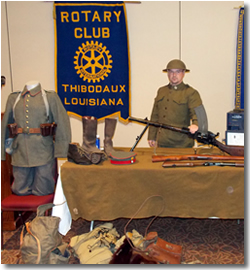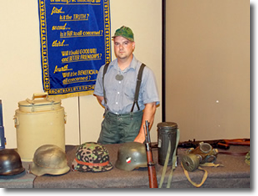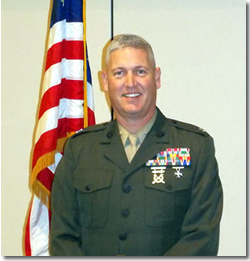Thibodaux Rotary Club | Ben Bernard “What They Saw In WW1”
November 13, 2012
By: Ken Gros
 Ben Bernard returned to the luncheon Tuesday with another interesting edition of “What They Saw” – World War I. He gave us a very brief history of the war and once again with the help of uniforms, equipment and weapons painted a portrait of the ordinary American and German soldiers.
Ben Bernard returned to the luncheon Tuesday with another interesting edition of “What They Saw” – World War I. He gave us a very brief history of the war and once again with the help of uniforms, equipment and weapons painted a portrait of the ordinary American and German soldiers.
For those who missed Ben’s previous presentations, “World War II – The German Soldier” and “What they saw – Vietnam”, Ben is a native of Cut Off and now lives in Thibodaux with his wife Lara and son Logan. He is a sales representative from Hyundai of Houma and Living Historian.
Ben is a historian and teaches through living reenactments for the National World War II Museum in New Orleans, Regional Reenactments, and visiting area schools teaching children about the life of the soldier in wars from the American Revolution, the Civil War, Vietnam and everything in between.
Ben has appeared in several History Channel programs based on World War II and the Vietnam War and assisted with the development of World War II Video games such as the popular “Call of Duty”. Ben’s grandfather was a Major in the Korean War and he became interested in war history at an early age. Ben has spent many hours with our fighting soldiers gaining an understanding of how war feels, and what is life really like for the men on the front lines.
Previously, Ben stressed the importance of detail, no matter how small, for reenactments to be successful. Participants “become” the soldier they are portraying and the more realistic the presentation the more informative it is.
Ben gave us a brief history of World War I. It was the first “Global War” and was different than any other conflict ever seen. It was a complicated war. Multiple nations were involved and were assembled in two opposing alliances, the Allies (France, Britain and Russia) and the Central Powers (Germany, Austria-Hungary and Italy).
America entered the war with the Allies in 1917 and fought until it’s conclusion in 1918. New technologies including aircraft, tanks, machine guns and chemical weapons were used. Because of these advancements in technology – and lethality of the new weapons, World War I was one of the deadliest conflicts in history.
Although both sides had plenty of new, impressive weapons, the soldiers in the field looked pretty ordinary. Ben was outfitted as an American GI or “Doughboy” including his brown wool uniform, low booties and a soft hat. He also donned a typical knapsack with usual implements including blankets, shovels and mess kits.
He explained how surprisingly, countries were just beginning to realize it was important for their fighting men to be comfortable in battle. GI’s standard rifle was the Springfield 1903 bolt-action 30-06. Select GI’s were issued the Winchester 1897 12-gauge shotgun which was very effective for trench warfare, however those who wielded it were shown no mercy if they were captured. Ben also showed us a standard issue “turtle shell” steel helmet with a crude camouflage pattern.
Next up was the German soldier. As usual the Germans appear to have one the fashion war. They donned a field grey wool uniform, leather boots with hobnails and a steel stahlhelm helmet – affectionately dubbed the frankenstien helmet by the allies because of two studs on its sides for attachment of a steel shield.
The helmets continued to be used throughout World War II. Soldiers used the Gewehr G-98 bolt-action mauser – the predecessor to the famous K-98, 8mm. Similar to other wars, the quality of uniforms and equipment was diminished by the end of the war as resources became scarce. Ben tried on a crude German gas mask; a grim reminder of the brutality of war.
When asked which soldier he prefers to reenact, Ben said the German soldier and went on a long explanation of why. I think it’s because the Germans seemed to have cooler toys than the Americans. Thank you Ben!
Thibodaux Rotary Club | Benjamin Bernard – WWII Reenactment
September 18, 2012
By: Kevin Gros
 Tuesday’s presentation was by Benjamin Bernard, a sales representative from Hyundai of Houma and Living Historian. Ben is a native of Cut Off and now lives in Thibodaux with his wife Lara and son Logan.
Tuesday’s presentation was by Benjamin Bernard, a sales representative from Hyundai of Houma and Living Historian. Ben is a native of Cut Off and now lives in Thibodaux with his wife Lara and son Logan.
Ben is a historian and when he’s not selling cars, he’s busy teaching history through living reenactments for the National World War II Museum in New Orleans, Regional Reenactments, and visiting area schools teaching children about the life of the soldier in wars from the American Revolution, the Civil War, Vietnam and everything in between.
Ben has appeared in several History Channel programs based on World War II and the Vietnam War and assisted with the development of World War II Video games such as the popular “Call of Duty”. Ben’s grandfather was a Major in the Korean War and he became interested in war history at an early age. Ben has spent many hours with our fighting soldiers gaining an understanding of how war feels, and what is life really like for the men on the front lines.
Thibodaux Rotary Club – Lieutenant Colonel Chris D. Landry
September 11, 2012
By: Luci Sposito
 Lieutenant Colonel Chris D. Landry is a native of Thibodaux, a 1980 E.D. White Catholic High School graduate, earned his BA from Nicholls State University in 1985, and later earned a Masters from Marine Corps University. He assumed his most recent assignment as the Deputy Operations and Plans Officer, G-3/5, Headquarters, Marine Forces Reserve in July 2011. He supervises the operational planning and employment of over 39,000 Marine Reserves to meet global demands.
Lieutenant Colonel Chris D. Landry is a native of Thibodaux, a 1980 E.D. White Catholic High School graduate, earned his BA from Nicholls State University in 1985, and later earned a Masters from Marine Corps University. He assumed his most recent assignment as the Deputy Operations and Plans Officer, G-3/5, Headquarters, Marine Forces Reserve in July 2011. He supervises the operational planning and employment of over 39,000 Marine Reserves to meet global demands.
Lieutenant Colonel Landry discussed the emerging security environment along with the sources of stress that are competing for resources including natural disasters, social unrest, hostile cyber activity, violent extremism (criminal, terrorist, religious), regional conflict, proliferation of weapons of mass destruction, and advanced weaponry in the hands of the irresponsible.
Statistics illustrate:
-70% of the world is water
-95% of international communications travels via underwater cables
-21 of the world’s 28 mega-cities are within 62 mi/100 km of the sea
-50% of the world’s population lives within 62 mi/100 km of a coast
-49% of the world’s oil travels through 7 major sea chokepoints
-42,000 trading ships are underway daily
-95% of the world’s commerce moves by sea
-95% of all commercial cargo travels through the littorals
According to Lieutenant Colonel Landry, a few of the matters worth considering are:
-China and the US are inextricably linked
-U.S. Military posture must be geographically distributed, operationally resilient, and politically sustainable
-U.S. must develop allies and coalitions
-Cyber security is critical to military operations and defense of homeland
He also discussed the pivotal role of the Asia-Pacific
-Twelve of the top 15 U.S. trading partners (import/export) are in Asia-Pacific
-From 2001-2010, approximately 70,000 people a year were killed in the Asia Pacific region due to natural disasters, resulting in -65% of world’s total death from such causes and approximately $35 billion of economic damage per year.
-Thirteen of the fifteen Megacities in the Asia-Pacific are within 100 km of the sea
-Fifteen of the world’s twenty-eight Megacities are in the Asia Pacific region
-Asia Pacific region contains 61% of the world population
-U.S. maintains five security treaties in the Asia-Pacific region
Lieutenant Colonel Landry discussed his experiences in Iraq and stated, “…I believe the military and all forms of government are strong… we are in good hands with those men and women in combat… they are doing an incredible job.”
He answered questions posed by the audience and stated that Bin Laden was just one target, but there were many other security issues to contend with regarding the Taliban. When asked about Iran, Lieutenant Colonel Landry stated, “We are keeping a close eye on things and that’s all I really want to say about that.” When asked if Pakistan was a friend or foe, Lieutenant Colonel Landry said, “It is not that simple to define as friend or foe. To be a friend, one has to find mutual goals and that is difficult in Pakistan.”
Finally, Lieutenant Colonel Landry explained that marine recruiting is successful and a recruiting goal has never been missed. His presentation ended with a standing ovation from our members.
